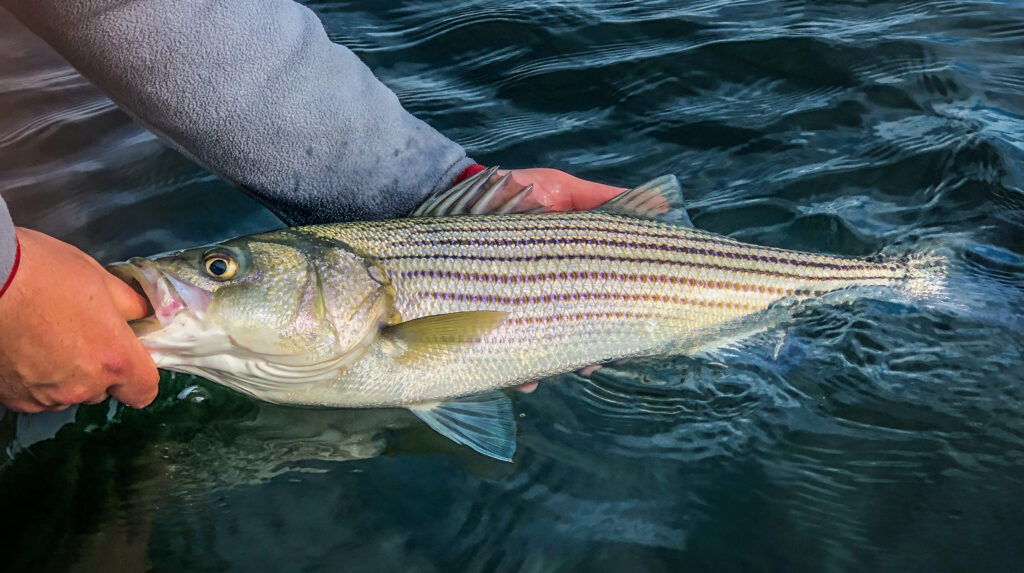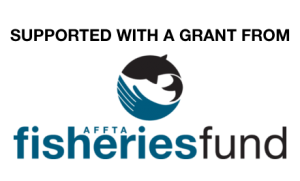ASMFC Draft Amendment 7: Public Comment Guide

By Taylor Vavra
Vice President/ National Board Member
As we have said before, this is now an all hands on deck situation. The period of state by state public hearings on Draft Amendment 7 of the ASMFC’s Striped Bass management plan is underway and written comments are now being accepted with a deadline of April 15, 2022. It is vital that the public speak up and let the Commission know we are not happy and that we are paying close attention to their actions moving forward. The fact is, because of your collective support for stronger conservation in the early days of this process a year ago, draft Amendment 7 was pushed farther toward stronger conservation than it would have been without your involvement.
While the state by state hearings are a welcome and valuable part of the process, they do not provide the public with the ability to fully express their commentary on draft Amendment 7. We certainly encourage everyone to attend and participate either in person or online, the polls being conducted are a new and an interesting way to gauge overall sentiment on options within the amendment. We are strongly suggesting, even if you have attended a hearing, that you also submit written comments to the Commision. Your written comments can be generated on your own time and you can choose to either select all options, as we have done below, or pick out whichever options are most important to you. Those options should be preceded by a short summary of your feelings about how the board has handled the management of Striped Bass and how you would like them to handle it going forward.
Here is the important part. Stripers Forever is not providing a form letter for you to copy and paste and send to the ASMFC. The reason behind this is the board has made it clear that form letters from organizations will not carry the same weight as those submitted by individuals writing in their own words. We could not disagree more with this policy. Capt. John McMurray (NY representative on the board and ASGA president) contested this openly with the board but unfortunately they choose to stick to their guns on this policy. It is vital that your comments be written in your own words. And while we provided some reasoning for our choices below you should not feel obligated to do the same in your submission to the commision.
Stripers Forever members were unified in our position that a ten-year equitable (recreational & commercial) harvest moratorium was needed. Many agreed with us, including other conservation groups and like-minded individuals, and they joined us in speaking out. The ASMFC took notice, and while they rejected the idea of a moratorium, significant changes were made to important provisions like restrictions on conservation equivalency, shorter triggers for mandated action, and a tacit acknowledgment from the Commission that recreational anglers have lost patience with twenty years of failure on the part of the ASMFC. We may be revisiting the implementation of a moratorium once the results of the next stock assessment are released in October 2022.
Our recommendation is to use these hearings and your letters to the Commission to turn up the heat. Let them know you are disappointed, angry, and paying close attention. Demand action and accountability to the Striped Bass’ dominant constituency. There are tens of thousands of us who want to see Striped Bass restored to abundance. We will no longer tolerate their failure. The bottom line is, your participation is more important than ever before, be part of the process!
Thank you for your support and dedication to the cause.
You may submit public comment by attending a public hearing held in your state or jurisdiction or mailing, faxing, or emailing written comments to the address below. Comments can also be referred to your state’s members on the Atlantic Striped Bass Management Board or Atlantic Striped Bass Advisory Panel; however, only comments received at a public hearing or written comments submitted to the Commission will become part of the public comment record.
Mail:
Emilie Franke
Atlantic States Marine Fisheries Commission
1050 N. Highland Street, Suite 200 A-N
Arlington VA. 22201
Email: comments@asmfc.org (Subject: Draft Amendment 7)
Fax: (703) 842-0741
For reference, here are few common terms which will help you better understand the language used within many of the options.
- F– Fishing Mortality Rate
- FMP– Fisheries Management Plan
- JAI– Juvenile Abundance Indices
- SSB– Spawning Stock Biomass
- TC– Technical Committee
The goal was to be as brief and clear as possible while still providing some reasoning for the options supported. Here are the options that Stripers Forever will support in our formal letter to the ASMFC and options we suggest our membership also support:
4.1 Management Triggers
TIER 1 OPTIONS: Fishing Mortality (F) Triggers
– Option A: Timeline to Reduce F to the Target– SF supports Sub-option A1 (status quo): Reduce F to a level that is at or below the target within one year.
-
-
-
- Reasoning: We believe that wherever possible the board should move as quickly as possible to reduce fishing mortality. Sub-option A1 offers the shortest timeframe to get it back below the target.
-
-
–Option B: F Threshold Triggers– SF supports Sub-option B1 (status quo): If F exceeds the F threshold, the striped bass management program must be adjusted to reduce F to a level that is at or below the target within the timeframe selected under Option A.
-
-
-
- Reasoning: Best of the two sub-options, action will not be taken under B2 unless a two year average of F exceeds the F threshold.
-
-
–Option C: F Target Triggers– SF supports Sub-option C1 (status quo): If F exceeds the F target for two consecutive years and female SSB falls below the SSB target in either of those years, the striped bass management program must be adjusted to reduce F to a level that is at or below the target within the timeframe selected under sub-option A.
-
-
-
- Reasoning: Best of the three sub options in regards to action trigger in the least amount of time. C2 requires 3 years of F exceeding F target and C3 has no trigger related to F target.
-
-
TIER 2 OPTIONS: Female Spawning Stock Biomass (SSB) Management Triggers
–Option A: Deadline to Implement a Rebuilding Plan– SF supports Sub-option A2: Two-Year Deadline to Implement a Rebuilding Plan. The Board must implement a rebuilding plan within two years from when an SSB-based management trigger is tripped. A management trigger is not considered tripped until the Board formally reviews and accepts, if necessary, the results of the relevant stock assessment.
-
-
-
- Reasoning: This option puts in place a two-year deadline to implement a rebuilding plan. A1 (status quo) does not put in place a deadline to implement a rebuilding plan.
-
-
–Option B: SSB Threshold Trigger– SF supports Sub-option B1 (status quo): If female SSB falls below the SSB threshold, the striped bass management program must be adjusted to rebuild the biomass to the target level within an established timeframe [not to exceed 10-years].
-
-
-
- Reasoning: B2 offers no trigger related to the female SSB threshold. We believe that while an F trigger would likely be in place it is also important to keep an eye on and take corrective measures if the female SSB is in trouble.
-
-
–Option C: SSB Target Trigger– SF supports Sub-option C1 (status quo): If female SSB falls below the target for two consecutive years and the fishing mortality rate exceeds the target in either of those years, the striped bass management program must be adjusted to rebuild the biomass to a level that is at or above the target within an established timeframe [not to exceed 10-years].
-
-
-
- Reasoning: Again, C1 offers the shortest time frame to rebuilding if the female SSB falls below the target. C2 requires 3 consecutive years and C3 contains no management trigger related to the female SSB target.
-
-
TIER 3 OPTIONS: Recruitment Triggers
–Option A: Recruitment Trigger Definition– SF supports Sub-option A3: The recruitment trigger is tripped when any of the four JAIs used in the stock assessment model (NY, NJ, MD, VA) shows an index value that is below the median of all values in the respective JAI from 1992-2006, which represents a period of high recruitment, for three consecutive years. The high recruitment reference period used for this trigger may be adjusted as recommended by the TC during benchmark stock assessments. This trigger alternative has a higher sensitivity than both the status quo trigger and sub-option A2 (Figure 1). This trigger alternative would have tripped six times since 2003: NY in 2006; MD in 2008; MD in 2009; MD and VA in 2010; NY in 2013; MD in 2014 (Table 2).
-
-
-
- Reasoning: The status quo (current trigger) has only been tripped once in the time period between 2003-2020, clearly it is not sensitive enough based on where the stock is currently at. A2 would have tripped the trigger 3 times in that same time period. A3, while classified as a “high sensitivity trigger”, would have tripped the trigger 6 times in that same time frame. As with the other options supported, we believe the board needs to operate with more caution moving forward, being aware of and addressing years of low recruitment ASAP.
-
-
–Option B: Management Response to Recruitment Trigger– SF supports Sub-option B2. If the recruitment trigger is tripped, an interim F target calculated using the low recruitment assumption is implemented, and if F from the terminal year of the most recent stock assessment is above the interim F target, the striped bass management program must be adjusted to reduce F to the interim F target within one year.
-
-
-
- Reasoning: In the past, the board has failed to adjust F to account for both good and bad year classes (recruitment). With several recent years of poor year classes we need the board to be more responsive to these shifts. B2 puts an interim F target adjustment in place if the recruitment trigger is tripped.
-
-
TIER 4 OPTIONS: Deferred Management Action
-SF supports Option A (status quo): No Deferred Management Action. If any (or all) of the management triggers are tripped following a benchmark stock assessment or assessment update, the Board is required to respond to that trigger regardless of when the last management action was implemented in response to any management trigger.
-
-
-
- Reasoning: We cannot support any options which allow the board to defer action if a management trigger is tripped. Options B-F all allow for deferred action by the board in the event of a management trigger. Given where the stock is currently at, overfished with overfishing occurring, the “Board’s concern about the frequent need for management action due to triggers tripping with each stock assessment update or benchmark” is quite frankly, absurd. Stock assessments are typically conducted every 2 years (COVID delayed the last one) and benchmark assessments every 5 years. If the board needs to convene and take action more frequently to maintain a healthy stock then so be it.
-
-
4.2 Recreational Fishery Management Measures
Option B. Effort Controls (Seasonal Closures)
-SF supports Sub-option B2. Spawning Area Closures: The Board can select either or both of the following sub-options B2-a and B2-b. Multiple states currently have spawning closures in place with closure boundaries defined by those states. Existing spawning closures would be applied toward meeting the requirements of the selected option(s).15 Spawning area closures during the spawning season could contribute to stock rebuilding by eliminating harvest and/or reducing releases of spawning and pre-spawn fish. Reducing releases during this time is particularly important to reduce stress and injury to fish as they move into lower salinity spawning areas. If new information on the timing of striped bass spawning is available in the future, the TC would conduct a review of that research and recommend changes to the timing of spawning closures if needed. If this option is selected, CE would not be permitted.
-SF supports Sub-option B2-b. No-Targeting Spawning Closure Required: All recreational targeting of striped bass would be prohibited for a minimum two-week period on all spawning grounds (not necessarily the entire spawning area) during Wave 2 (March-April) or Wave 3 (May-June), as determined by states to align with peak spawning. States will determine the boundaries of spawning ground closures. Closures prohibiting recreational targeting on spawning grounds have already been implemented in Maine (Kennebec River), New Jersey (Delaware River), and Maryland (Chesapeake Bay) during part of Wave 2 and/or Wave 3 (Figure 4).
-
-
-
- Reasoning: This is an important one! And while this is a complex section of Amendment 7 we believe it is vital to the recovery of the SSB and stock as a whole. Sub-option b2-a would prohibit harvest but allow for catch and release, b2-b would be a no targeting closure and would provide the best protection for the SSB while they spawn. The option is somewhat open ended with the language calling for a “minimum two-week period,” we would like to see it closer to a four or six week period in order to see the best results and gain the most protection for the SSB. Many other species benefit from shortened seasons or spawning closures and Striped Bass should as well. Considering the stock is currently overfished with overfishing occurring, the least we can do is allow for uninterrupted spawning. The argument that Striped Bass would be a bycatch while fishing for Bluefish or other species is mostly null as Bluefish do not show up in great numbers until after this timeframe. The uncertainty regarding these options surround the definition of the spawning areas and the possibility that states may need to work together to provide the most amount of protection for the SSB as they stage ahead of the spawn and then move up into the river to do so. The best example of this is the case of the Hudson River where fish stage in Raritan Bay, New Jersey before ascending the Hudson River to spawn in NY. In a best case scenario this targeting closure would not only protect the spawning grounds but also the areas in which the SSB congregates prior to spawning, they go hand in hand. Despite these uncertainties we support these options with the hope that the TC and board will work together to develop these areas. Overall these options err on the side of caution but with the Striped Bass SSB and stock as a whole being in such a dire situation, we believe any gain, no matter how big is worth the risk involved.
-
-
Option C. Additional Gear Restrictions
-SF supports Sub-option C1: Recreational anglers would be prohibited from using any device other than a nonlethal device to remove a striped bass from the water or assist in the releasing of a striped bass.
-SF supports Sub-option C2: Striped bass caught on any unapproved method of take would be returned to the water immediately without unnecessary injury.
-
-
-
- Reasoning: These options are a no brainer. Let’s prevent the use of gaffs for removing fish from the water in the event that they would need to be released as slot limits require more fish to be released. C2 would require non circle hooked fish (J-hook when fishing for other species) to be returned to the water as soon as possible and with careful handling. Both of these measures combat recreational release mortality which has been determined to have a large effect on F.
-
-
Option D. Outreach and Education
-SF supports Sub-option D1: States would be required to promote best striped bass handling and release practices by developing public education and outreach campaigns. States must provide updates on public education and outreach efforts in annual state compliance reports.
-
-
-
- Reasoning: Another easy option. States collect license fees and we believe some of that money should be spent on angler education and more specifically catch and release best practices. Option D2 only recommends that “states continue to promote best striped bass handling and release practices by developing public education and outreach campaigns.” We believe that this should not just be a recommendation but a requirement. Angler education is an essential method to help curb recreational release mortality and ultimately help rebuild the stock to abundance.
-
-
4.4 REBUILDING PLAN
4.4.1 Recruitment Assumption for Rebuilding Calculation
-SF supports Option B: Rebuild female SSB to the SSB target level by no later than 2029. F rebuild is calculated to achieve the SSB target by no later than 2029 using the low recruitment regime assumption as identified by the change point analysis.
-
-
-
- Reasoning: As we have mentioned, young of year over the past 3 years has been well below average. Combine this with the fact that Addendum 6 only addressed mortality and not rebuilding the stock and now we are in a terrible spot. The writing has been on the wall for years, if you were on the water it was clear that the stock was in trouble. Option B bases the rebuild of the SSB on the ‘low recruitment regime assumption,’ more in line with the poor year classes previously mentioned. It would likely achieve a lower level of removals and require more restrictive management measures.
-
-
4.4.2 Rebuilding Plan Framework
-SF supports Option B: If the 2022 stock assessment results indicate the Amendment 7 measures have less than a 50% probability of rebuilding the stock by 2029 (as calculated using the recruitment assumption specified in Amendment 7) and if the stock assessment indicates at least a 5% reduction in removals is needed to achieve F rebuild, the Board may adjust measures to achieve F rebuild via Board action.
-
-
-
- Reasoning: A new stock assessment will be published in October 2022 and depending on the outcome it may have a massive impact on the measures being put in place by Amendment 7. It is an unfortunate situation and likely could have been avoided if the board took action sooner but it is a concession we should be willing to make to prevent a further delay in developing and putting into action an addendum to Amendment 7. As noted it appears the board is willing to allow some sort of public involvement in the process. “Under this option, public comment could be provided during Board meetings per the Commission’s guidelines for public comment at Board meetings, and/or public comment could be provided in writing to the Board per the Commission’s timeline for submission of written public comments prior to Board meetings.”
-
-
4.6 ALTERNATIVE STATE MANAGEMENT REGIMES
4.6.2 Management Program Equivalency (Conservation Equivalency or CE) | Option B. Restrict the Use of Conservation Equivalency Based on Stock Status
-SF supports Sub-option B1. Restrictions: CE programs would not be approved when Sub-option B1-a: the stock is at or below the biomass threshold (i.e., overfished). CE programs would not be considered until a subsequent stock assessment indicates stock biomass is above the threshold level.
-
-
-
- Reasoning: While we were hoping to see conservation equivalency completely removed from the management process, that is not an option within Amendment 7. The TC has stated that the implementation of CE in the management process is unquantifiable and will likely cloud the regulations put in place by states to reach the overall reductions necessary. Option B, sub-option B1 provides the most limitations to the use of CE by states, some of whom have taken advantage of it. The stock needs to be managed for abundance and therefore we need to let the Commision know that CE has no place in a stock that is overfished with overfishing occurring. If you only choose to speak on or select a few options from A7, this should certainly be one of them.
-
-
4.6.2 Management Program Equivalency (Conservation Equivalency or CE) | Option C. Precision Standards for MRIP Estimates Used in Conservation Equivalency Proposals
-SF supports Sub-option C3: CE proposals would not be able to use MRIP estimates associated with a PSE exceeding 30.
-
-
-
- Reasoning: This is the most conservative option available as as stated in Amendment 7 “NMFS warns that ‘[MRIP] Estimates should be viewed with increasing caution as PSEs increase beyond 30. Large PSEs—those above 50—indicate high variability around the estimate and therefore low precision.'”. We want to make sure the CE is only accessible if tightest estimate and least amount of risk.
-
-
4.6.2 Management Program Equivalency (Conservation Equivalency or CE) | Option D. Conservation Equivalency Uncertainty Buffer for Non-Quota Managed Fisheries
-SF supports Sub-option D3: Proposed CE programs for non-quota managed fisheries would be required to include an uncertainty buffer of 50%.
-
-
-
- Reasoning: An uncertainty buffer refers to the previously mentioned unquantifiable results of states putting CE in place as pointed out by the TC. What this means in simple terms is, if a state wants to make use of CE they will need to plan for a buffer to account for possible overages of F. In other words it could be thought of as a tax for using CE. This will hopefully discourage states from using CE in the first place. We would like to see the biggest buffer possible (50%) put in place to dissuade states from trying to use CE. If they do opt to use it the 50% buffer would hopefully counteract the potential overages in F.
-
-
4.6.2 Management Program Equivalency (Conservation Equivalency or CE) | Option E. Definition of Equivalency for CE Proposals with Non-Quota Managed Fisheries
-SF supports Sub-option E2: Proposed CE programs would be required to demonstrate equivalency to the percent reduction/liberalization projected for the FMP standard at the state-specific level.
-
-
-
- Reasoning: This is a bit convoluted but the bottom line is that this essentially undoes an unfortunate series of events that transpired during the addendum 6 process. New Jersey felt that the coastwide 18.5% reduction based on harvest was unfair as it translated to a larger reduction for them due to the complication of the slot limit. The board sided with New Jersey who then ultimately failed to meet its goals and in the end took no reduction.
-
-
This concludes the section of draft Amendment 7 options for which the ASMFC is seeking public input. This was a beast of a document and we did our best to distill it into something of value for our Stripers Forever members. Our greatest hope is that you be a part of the process and make your voice heard, no matter what your opinion may be. If we all band together and let the commission know we expect accountability and change it may happen. We will be working hard to generate awareness about Amendment 7 through our normal communications channels. Sign up to receive our emails (free) and follow us on Instagram (@stripersforever) as well as Facebook. As we move beyond Amendment 7 look for updates on all legislative action regarding Striped Bass, especially the next stock assessment in October 2022.
Thank you again for your support!
LINKS:
Draft Amendment 7: http://www.asmfc.org/uploads/file/61fd9572AtlStripedBassDraftAm7forPublicComment_Feb2022.pdf
State by State Public Hearing Schedule: http://www.asmfc.org/uploads/file/621e9697pr05_StripedBassAm7PublicHearings_revised.pdf
ASMFC Atlantic Striped Bass Draft Amendment 7 Presentation (video): https://youtu.be/tjUw92-Xl-4







